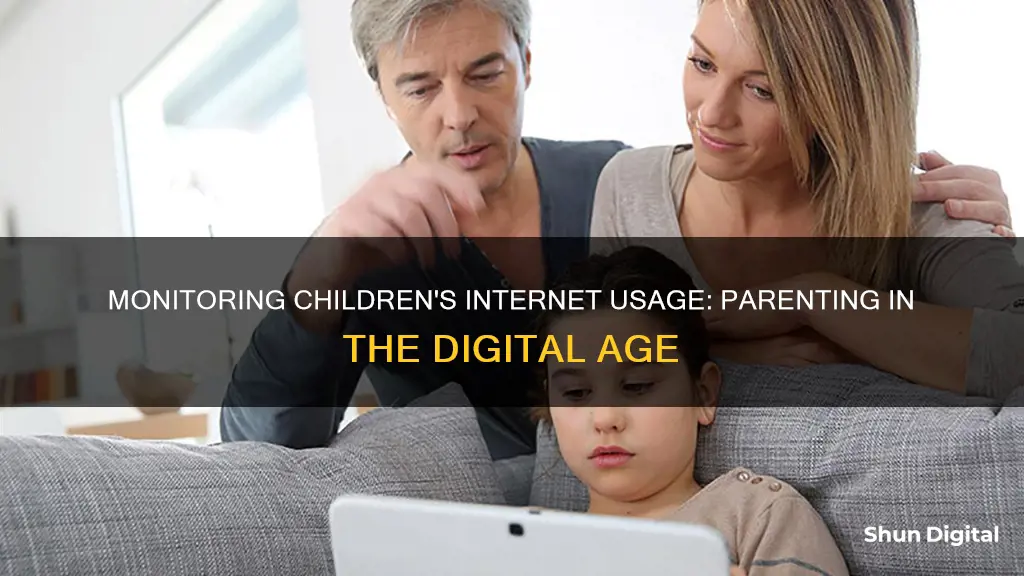
The internet is a vast resource, offering entertainment, information, and a space for people to connect and communicate. While it has its benefits, the internet also poses several risks, especially for children and teenagers who may be unaware of online dangers. As such, many parents are faced with a dilemma: should they monitor their children's internet usage or not?
| Characteristics | Values |
|---|---|
| Protecting children from online dangers | Cyberbullying, sexting, online predators, identity theft, viruses and malware, etc. |
| Parental involvement | Monitoring children's devices, setting up profiles/parental controls, limiting screen time, teaching online safety, etc. |
| Building trust | Encouraging open and honest communication, respecting privacy, fostering independence |
| Preventing negative impacts | Excessive screen time, exposure to inappropriate content, social isolation, etc. |
| Safety | Protecting personal information, safeguarding reputation, preventing financial scams |
What You'll Learn

Cyberbullying
Monitoring a child's internet activity can help parents identify if their child is being cyberbullied or is engaging in cyberbullying behaviour. Many children who are cyberbullied feel ashamed or afraid to tell a trusted adult, so monitoring can bring this issue to light. Additionally, monitoring can help parents address other online risks, such as sexting, online predators, and the sharing of personal information.
Strategies for Monitoring
- Use monitoring software and apps: There are various monitoring software and apps available, such as Net Nanny, Qustodio, and WebWatcher, that can help parents oversee their children's online activities. These tools can monitor social media accounts, alert parents to inappropriate language or content, and provide detailed reports of browsing history.
- Know your child's passwords: Some parents choose to have their children's passwords for email and social media accounts to directly monitor their online activity.
- Stay up-to-date: Parents can keep themselves informed about the latest apps, social media platforms, and digital slang used by children to better understand their online world.
- Establish rules and set boundaries: Parents can establish rules about appropriate digital behaviour and set boundaries on device usage, such as limiting screen time or blocking certain websites.
- Be a part of their online world: Parents can request to friend" or "follow" their children on social media platforms. This allows them to check their child's postings and the sites they visit, while also showing interest in their online activities.
- Keep an open dialogue: Talking to children about their online experiences and teaching them about online safety can help them develop healthy habits and encourage them to come to parents if they encounter cyberbullying.
Considerations
While monitoring can be a useful tool, it is important to consider the potential drawbacks. Some critics argue that constant monitoring invades children's privacy and can lead to mutual distrust. Additionally, children may find ways to hide their online activities if they feel they are being spied on. Therefore, it is crucial to balance monitoring with open communication and digital education.
It is also important to remember that monitoring alone will not prevent cyberbullying. Teaching children about the benefits and dangers of the digital world and modelling positive online behaviour can help them make better decisions and navigate the online world safely.
Monitoring Electricity Usage: A Guide to Tracking Your Power Consumption
You may want to see also

Online Predators
The internet has become an integral part of children's lives, with social media and online gaming providing new avenues for them to connect and interact with their peers. However, the online world also poses risks, with online predators being one of the most serious concerns for parents.
The tactics used by online predators can be highly deceptive. They often pretend to be children or teenagers themselves, sharing similar interests and building false trust with their targets. They may also use manipulation and introduce minors to sexual content, requesting explicit images or information. In some cases, they may even attempt to meet their victims in person, luring them into dangerous situations.
Children between the ages of 12 and 15 are particularly vulnerable to online predators, according to the FBI. It is estimated that over 50% of victims of online sexual exploitation fall within this age group. Additionally, 89% of sexual advances directed at children occur in internet chat rooms or through instant messaging. The potential for real-life encounters and the serious nature of these crimes highlight the importance of parental awareness and intervention.
While some parents may be reluctant to monitor their children's online activities due to privacy concerns, the potential risks posed by online predators cannot be ignored. Parental monitoring can be an effective tool to protect children from online dangers. By being vigilant, parents can identify suspicious behaviour and intervene before any potential harm occurs.
To effectively monitor their children's internet usage, parents can employ various strategies. These include setting up parental controls, using filtering software, and regularly checking their children's devices and online activities. Additionally, educating children about online safety, encouraging open communication, and promoting responsible digital citizenship can empower them to make better decisions and recognise potential threats.
In conclusion, while the internet offers numerous benefits, it is essential for parents to be proactive in protecting their children from online predators. By finding a balance between privacy and safety, parents can create a secure online environment for their children to explore and learn.
Monitoring PSU Usage: A Comprehensive Guide to Tracking Power Supply Performance
You may want to see also

Identity Theft
Children are prone to giving out too much information online, which makes it easy for someone to steal their identity. Identity theft occurs when someone uses a child's personal information, such as their name, Social Security number, address, or date of birth, to open bank accounts, credit card accounts, or commit fraud.
- Ask questions before giving anyone your child's Social Security number. Inquire about alternative forms of identification, how the information will be protected, who will have access to it, and how it will be disposed of when it's no longer needed.
- Protect documents with personal information. Keep them in a safe place, such as a locked file cabinet, and shred them before disposal.
- Delete personal information from devices before getting rid of them.
- Educate your children about not giving out personal information without your permission.
- Monitor your child's internet activity to ensure they are not sharing too much information.
If you suspect your child's identity has been stolen, here are some steps to take:
- Contact the companies where fraud occurred and ask them to close the fraudulent accounts.
- Contact the three credit bureaus and request a credit freeze to prevent new accounts from being opened in your child's name.
- Report the identity theft to the Federal Trade Commission at IdentityTheft.gov.
By taking proactive measures and staying vigilant, you can help protect your child from the serious consequences of identity theft.
Monitoring Bandwidth Usage: Strategies for Effective Network Management
You may want to see also

Viruses and Malware
Malware is a malicious software that causes harm by obtaining personal information. It can secretly infect any computer through infected websites, bad software, music and movie file-sharing sites, and even seemingly innocent online video games. It can expose children to harmful material, wreak havoc on computers, and spread to other devices.
Install Anti-Malware and Antivirus Software
Anti-malware and antivirus software can protect your child's device from unwanted viruses and malware. It can block "suspect" programs and conduct daily scans to identify and remove threats.
Set Up Digital Boundary Rules
Establishing digital boundaries with your children is crucial. It helps them understand that the Internet can be a great resource for information, entertainment, and communication, but it also poses potential dangers. Involve them in the decision-making process by asking for their input on rules and restrictions.
Create a Safe Space with Parental Controls
Parental controls can be installed on devices such as smartphones, laptops, tablets, and computers. These controls allow you to block inappropriate websites, monitor your child's online activity, and set usage restrictions based on the time of day.
Educate Your Child
Teach your child about the risks of viruses and malware in a way that is age-appropriate. Emphasize the importance of safeguarding personal information and being cautious about downloads and online interactions. Encourage them to come to you if they encounter something suspicious.
Keep Software Updated
Ensure that your child's devices have the latest security patches and updates. Most updates include fixes for known vulnerabilities, providing an extra layer of protection against viruses and malware.
Backup Data Regularly
Regularly back up important data to an external drive or cloud storage. This way, if your child's device does get infected, you can mitigate the damage by restoring data from a backup.
Use a Firewall
Enable the built-in firewall on your operating system or install a reputable third-party firewall for added protection against external threats.
Practice Email Safety
Educate your child about the dangers of opening email attachments from unknown sources. Teach them to verify the sender's identity and exercise caution to prevent the spread of viruses and malware.
Keep Privacy Settings Updated
Review and adjust the privacy settings on your child's social media accounts and apps regularly. Ensure that their personal information is not shared with strangers to minimize the risk of identity theft and online exploitation.
While monitoring your child's online activity, it is essential to maintain open communication and provide age-appropriate education about online safety. By empowering your child with knowledge and establishing boundaries, you can help them navigate the digital world safely and make informed decisions about their online behavior.
Monitoring Linux CPU Usage: A Comprehensive Guide
You may want to see also

Screen Time and Online Activity
To effectively monitor screen time and online activity, parents can employ a combination of approaches. One method is to set up profiles on their children's devices, such as smartphones, tablets, and computers, to restrict access to certain apps, games, and websites. This allows parents to control the type of content their children engage with. Parents can also set time limits on internet usage to prevent excessive screen time.
Another approach is to regularly check in on their children's online activities. This can include reviewing their web browsing history, social media profiles, and phone call records or messages. While this may be seen as an invasion of privacy, it can help parents identify potential risks and guide their children in navigating the digital world safely. It is important for parents to communicate their reasons for monitoring to build trust and encourage open dialogue with their children.
Furthermore, parents can utilise parental control tools and monitoring software to block or filter online content. These technological solutions can provide additional support in managing their children's screen time and online exposure. However, it is important to note that children may find ways to circumvent these controls, so open communication and education about online safety are crucial.
Additionally, parents can create family email accounts for younger children, allowing them to monitor contacts and communications. Social media sites typically require children to be at least 13 years old to create an account. Parents can create their own accounts on these platforms to monitor their children's activity and set a positive example for responsible online behaviour.
By combining these strategies, parents can actively play a role in guiding their children's screen time and online activity while also fostering a trusting and educational environment. It is essential to adapt these strategies as children grow older, gradually giving them more independence while ensuring their safety and well-being.
Medical Device Safety Compliance: Who Monitors Usage?
You may want to see also
Frequently asked questions
The internet can be a dangerous place for children. They can be exposed to cyberbullying, sexting, online predators, identity theft, viruses and malware, and inappropriate content.
Parents can monitor their children's internet usage by using monitoring software, checking their web history, setting up parental controls, and regularly reviewing privacy settings on social media accounts.
Monitoring a child's internet usage can help protect them from online dangers, teach them about internet safety, and limit their screen time. It can also help parents identify any issues their child may be facing, such as cyberbullying or inappropriate content.







